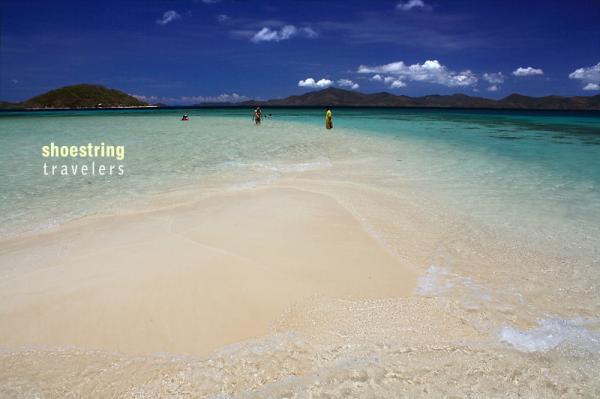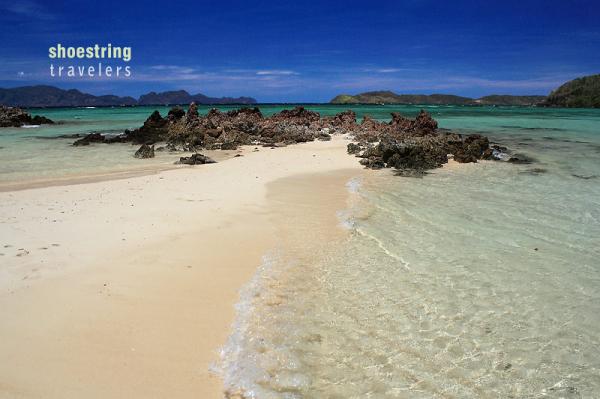
You may also check these:
https://shoestringtravelers.com/?q=node/71
It was a bright,sunny and and warm April morning and we were looking forward with excitement towards our first island destination of the day. However, within minutes of leaving the pier at Coron town, our outrigger boat found itself fighting an unusually rough sea. Wet from salt spray, we were not particularly worried as only a strong typhoon can tip our boat over. But with our boat forced to cut its speed to a crawl several times, we wondered if we could reach the island of Bulog Dos within the 1.5 hour time frame that we were told was the normal time to sail to the island.
Bulog Dos
We finally made it to Bulog Dos after almost two hours of bobbing up and down the waves – and that in the middle of the hot month of April(!). However, the view that greeted us as our boat came to a stop at Bulog Dos’ immaculate white sandy beach made us quickly forget our misadventure. Bulog Dos’ white sand and crystal clear waters beckon.
Bulog Dos’ white sand and crystal clear waters beckon.
Bulog Dos is one of the many beautiful islands of the Calamianes. It is located close to the tip of Malaroyroy Peninsula at the northern end of Bulalacao, an island located southwest of Coron Island and adjacent toCulion Island (Bulog Dos is actually closer to Culion than Coron). It was part of a 3-island destination for our second day of island-hopping in Coron, Palawan. We were told that Malaroyroy Peninsula itself is no longer accessible to the public since the construction of the Two Seasons Resort on that location. One can easily see Two Seasons from Bulog Dos but you cannot go any further from beyond a hill overlooking the resort. The Two Seasons Resort in the background, just beyond the sandbar projecting away from Bulog Dos.
The Two Seasons Resort in the background, just beyond the sandbar projecting away from Bulog Dos.
No matter. Bulog Dos itself looks more beautiful with its short stretch of white sandy beach, crystal-clear aquamarine waters and a long snaking sandbar that connects it to Malaroyroy Peninsula and the rest of Bulalacao. Since we arrived before noon a large part of the sandbar was still covered with ankle-deep water, but even then the view was already quite incredible.
 Bulog Dos’ sandbar stretches all the way to Malaroyroy Peninsula.
Bulog Dos’ sandbar stretches all the way to Malaroyroy Peninsula.
But what makes Bulog Dos unique from the islands we visited near Bulalacao and Culion is its collection of rock formations. It was a photo paradise for Leo as he proceeded to snap these pictures:


 Rock formations on Bulog Dos.
Rock formations on Bulog Dos.
Another wonderful discovery we made in Bulog Dos is the presence of colorful corals and a variety of other marine life several meters off the beach and just beyond the layer of sea grass close to shore. The fishes here are not shy and would even swarm around you. Our tour guide and boat guys were very helpful, assisting the non-swimmers in our group to get a good view of the underwater spectacle. We’ve read in another blog that there were sting ray sightings here although we did not see any during our visit.
 Those waters are teeming with colorful marine life.
Those waters are teeming with colorful marine life.
Banana Island
Next on our island-hopping list was Banana Island, a location only about five minutes sailing time from Bulog Dos. Banana Island is more officially known as Dicalabuan Island. (We still have to hear a satisfactory explanation why it ended up being called Banana Island.) Like Bulog Dos, it is privately owned but open to the public for an entrance fee. Banana Island was our lunch stop for the day. It has several cottages where guests can stay overnight along with huts and tables where we had our lunch. There are also several hammocks where you can rest or take a nap as several in our group did right after lunch.
 Hammocks under the trees: just make sure those coconuts stay in place while we’re napping.
Hammocks under the trees: just make sure those coconuts stay in place while we’re napping.
The beach here isn’t as nice as in Bulog Dos (and Malcapuya). Much of the beach is covered by pebbles mixed with sand although there is a stretch of beach where the sand is dazzlingly white and fine. A volleyball net has been set-up along this stretch. The island also offers kayaking to enthusiasts. There are more facilities here than in Bulog Dos and Malcapuya which is probably the reason why it is often the choice of tour operators for lunch stopovers.
 A stretch of fine, white sandy beach on Banana Island.
A stretch of fine, white sandy beach on Banana Island.
We didn’t get to try snorkeling here although there seems to be reef several meters out to shore. Most of those in our group were content to rest in those hammocks after maxing their time in Bulog Dos.
 Banana Island for the moment has more facilities than either Bulog Dos or Malcapuya.
Banana Island for the moment has more facilities than either Bulog Dos or Malcapuya.
It even has trees that try to make an autumn impersonation.
On our way to Banana Island from Bulog Dos, we noticed a sandbar jutting out from Banana Island to Malaroyroy Peninsula. We hiked over to the base of this sandbar and realized that it might be possible to walk all the way to Malaroroy and Bulog Dos using this sandbar. Indeed some bloggers were saying one can walk through chest-deep water when the low tide is at its maximum to reach Malaroyroy from Banana Island through this sandbar. We didn’t have the time and energy to find out, however, since we still had an island to go before going back to Coron.
Getting There
Bulog Dos and Banana Islands are part of a three-island tour package being offered by tour operators in Coron town (Malcapuya Island is the third destination). Some of these operators have online access. We tried one but they were fully booked. Fortunately we saw one operator in Coron town – Nice in Paradise – that offered tour packages including the Coron Island Loop and the 3 Islands Tour featuring Bulog Dos, Banana and Malcapuya Islands. Our P1,200 fee per person included the entrance fees for all 3 islands and a hearty lunch that included vegetable salad, grilled fish, pork, chicken and crabs. We even had snacks served in Malcapuya.
These boat tours are economical if you are traveling alone or with just a few people. Boats traveling to these distant places have to be large enough to withstand strong waves in the open seas and therefore will require a lot more fuel than smaller boats. Most of them can accommodate 15 passengers so the operators will pair you off with other groups to fill up the boats. The only problem with this arrangement is that you cannot choose the destinations you want since these are usually fixed. All things considered however, these shoestring travelers think it’s a good deal for people traveling alone or in a small group.
Go to this link to know how to get to Coron Island.










